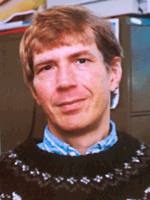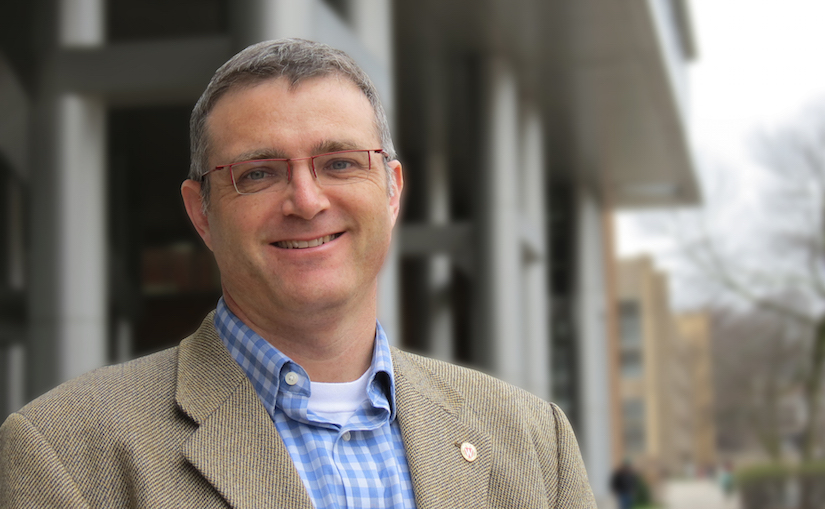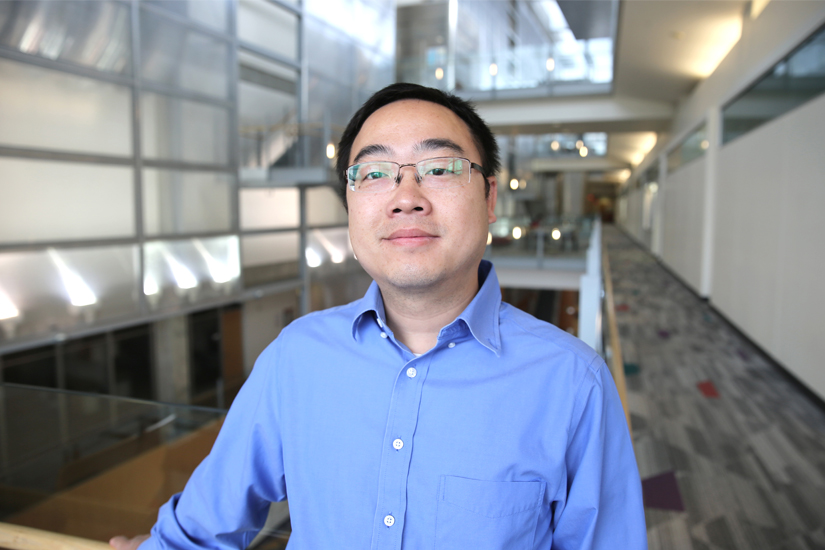
Bonazza
Prof. Bonazza research group completed an experimental campaign centered on the concurrent performance of high-speed (20 kfps) planar laser-induced fluorescence and particle image velocimetry to measure the concentration and velocity fields at a gas interface accelerated by a planar shock wave. This was only the second time experiments of this kind were carried out anywhere in the world.
Prof. Bonazza and his graduate students completed a major upgrade of the wind tunnel facility currently used for the EMA522 Aerodynamics Laboratory course. Hopefully, the facility will also be used for research by future faculty hired in the department.

Bronkhorst
Bronkhorst had a very active year. He once again taught Mechanics of Continua (EMA 622) and FEM Practicum (EMA 405) and Fracture Mechanics (EMA 519) for the first time. He serves as chair of the Undergraduate Studies Committee and member of the Graduate Studies Committee. He continued to publish in highly regarded journals with seven published and submitted. He supervised three PhD students and two undergraduate research students. He also advises 30 undergraduate students. He continues his service as associate editor of the International Journal of Plasticity, guest editor for a special issue of the Journal of the Dynamic Behavior of Materials, guest editor for a special issue of the International Journal for Multiscale Computational Engineering He also serves on the executive committee of the ASME Materials Division. He also serves in several other roles on campus, state of Wisconsin, and U.S.

Choy
Prof Choy continues to develop her research programs in experimental quantum sensing and photonic engineering, which are being supported by the Department of Energy, Office of Naval Research, National Science Foundation, and the Wisconsin Alumni Research Foundation. She was invited to give numerous talks and seminars on her group’s research activities to academic and industry audiences, including a Quantum Technologies Webinar hosted by Hamamatsu. She has served on or chaired conference committees for OSA and IEEE and organized the first quantum-focused sessions at the OSA Optical Sensors and Sensing Congress.
Prof Choy taught EMA 550 (Astrodynamics) for the first time in Spring 2021 and updated her special topics course in quantum engineering in the Fall.

Couet
Prof. Couet obtained the Grainger Associate Professorship along with tenure. Additionally, Couet was awarded a Vilas Early-Career Investigator Award, which recognizes research and teaching excellence in faculty who are relatively early in their careers. The MADCOR lab run by Couet had a successful year achieving grant funding. With grants awarded from various institutions such as the Naval Nuclear Laboratory, the Department of Energy: Nuclear Energy, and Department of Energy: High-Energy Physics, MADCOR received more than $1M in funding.
Outside of research, Couet played a critical role in organizing the 2022 Nuclear Innovation Bootcamp held in Madison. Participants in the bootcamp come from a variety of countries with backgrounds ranging from engineering to business to policy. Couet also developed a brand-new Introduction to Nuclear Engineering course for first year undergraduate students, which was taught during spring semester ’22. The course exposes students to many aspects of the field, includes a hands-on semester-long project, and doesn’t shy away from controversies related to nuclear energy.

Crone
Prof. Wendy Crone has recently been named a Program Director within the Directorate for
Engineering at the National Science Foundation (NSF). Her responsibilities span the Biomechanics & Mechanobiology (BMMB) Program, the Mechanics of Materials and Structures (MoMS) Program, and the Major Research Instrumentation (MRI) Program in the Division of Civil, Mechanical and Manufacturing Innovation (CMMI). This position takes advantage of both her research expertise in mechanics as well as her prior experience in administrative oversight of grants and awards programs.

Diem
Prof. Diem was selected by the National Academies as a member of the 2021-2023 New Voices in Science, Engineering and Medicine. The New Voices program was launched by the NASEM in 2018 as an initiative to bring diverse perspectives from early-career U.S. leaders to important dialogues around how science, engineering and medicine are shaping the global future. As PI of the Pegasus-III Experiment, she continues to lead the project through a major facility upgrade that completed the decommissioning phase of the project and has entered the assembly and commissioning phase. The Pegasus-III Experiment studies innovation in plasma startup techniques in an effort to reduce the cost and complexity of future fusion reactors. As an instructor for N E 427: Nuclear Instrumentation Laboratory for Spring 2021, Prof. Diem continued to teach in a hybrid class format to support students during these challenges circumstances.
Diem continued to be an active member in the plasma physics and fusion energy community, serving on the APS-DPP Executive Committee, the APS-DPP Committee on Women in Plasma Physics (WiPP), was elected the Vice Chair of the Sherwood Executive Committee and elected to the University Fusion Associates (UFA) Executive Committee. Additionally, she was a featured speaker for the 2021 Fusion Day Congressional Briefing, the keynote speaker for the 2021 Young Women’s Conference in STEM and is the faculty mentor for the newly formed Solis student group, sponsored by APS, that seeks to support women and gender minorities in plasma physics across the UW-Madison campus. Diem also co-lead the launch of the Plasma and Fusion Undergraduate Research Opportunities program that provided research experiences for undergraduates at U.S. undergraduate institutions and is funded by the DOE Office of Fusion Energy Sciences and co-lead the design and launch of the USFusionEnergy.org website.

Franck
Professor Franck continues to grow the Computational Flow Physics and Modeling group, which now has 6 graduate students (3 joined in 2021) and 3 undergraduate researchers. In 2021 the group had its first PhD student graduate: Kate Lyons successfully defended her thesis on the turbulence and vortex structures surrounding flow over seal whiskers. Two undergraduate researchers graduated in May 2021 and are now attending top ranked PhD programs at MIT and University of Illinois-Urbana Champaign. The group’s research thrusts are now more aligned with clean and renewable energy, with two new federal grants on Marine Energy Cross-Flow Turbines in collaboration with the University of Washington.
Prof Franck became the Graduate Women in Mechanical Engineering (GWME) faculty advisor in 2021, helping to grow and expand the scope of the student group. GWME is aimed at female and gender minority graduate students and postdocs from the Engineering Physics and the Mechanical Engineering departments. The group hosts professional development, networking and social opportunities for students and researchers to feel welcome and supported throughout their time at UW-Madison.

Geiger
Benedikt Geiger has formed a multi-disciplinary and well interlinked research group that addresses anomalous particle and heat transport in fusion plasmas. He and his group has developed new spectrometer designs and has prepared diagnostic equipment and analysis techniques for upcoming experiments at the W7-X stellarator, the DIII-D tokamak and the NSTX spherical tokamak experiments.

Hegna
Prof. Hegna continues to have a thriving research lab, with two PhD candidates graduating in 2021. Additionally, Hegna has been focusing on furthering activities of Type One Energy Group, Inc., a company he helped co-found.

Lakes
This year, Professor Lakes taught the annual lab class EMA 611 and EMA 630, Viscoelastic solids. With better access to the lab we were able to resume a more reasonable pace of progress on research. We have successfully continued our programs of study of the nonclassical properties of rib lattices, known as metamaterials. We have obtained theoretical links between rotation sensitivity in nonclassical elastic solids (observed in our laboratory) and rotation sensitivity in gravitation (called torsion, hypothesized, sought, but not observed). We have shown experimentally that a well studied practical truss lattice is nonclassical in its elastic response.

Lindley
In 2021, Ben Lindley progressed his group’s research in flexible operation of nuclear power and integrated energy systems as part of two ongoing NEUP projects. The group expanded significantly, with exciting new research avenues in advanced nuclear reactor physics and reactor design.

Notbohm
Dr. Notbohm’s research program was productive this year, with several peer-reviewed manuscripts published, and two students graduating with Ph.Ds from the Engineering Mechanics program. As a form of outreach, Notbohm’s research program hosted two high school teachers from the Milwaukee area during the summer. The teachers engaged in research in the Notbohm lab, and designed a lab activity for their high school classrooms on mechanical behavior of biological materials like tendons. In addition to his normal teaching load, Dr. Notbohm spent time improving the experience of students taking courses during the pandemic. In particular, he worked with a team to teach a large enrollment course in a hybrid format, giving each student in that course an opportunity to engage in an in-person component, and he secured funding and led a collaboration to implement group quizzes in Statics, the larges course offered by the College of Engineering. These efforts enabled students to interact with one another more so than is typically possible in remote course format.

Sovinec
Prof. Carl Sovinec’s research group is refactoring the widely used NIMROD simulation code to make it computationally efficient for stellarator applications. Stellarators and related magnetic-confinement configurations have strong helical shaping, and plasma dynamics are best represented, numerically, on a mesh that follows the helical shaping. Generalizing the geometry is one aspect of the development. The other is incorporating a new representation for magnetic field that inherently preserves the conservation of magnetic flux. Sovinec continues to lead the broader NIMROD Team, which includes collaborators from across the country and overseas.

Sridharan
Prof. Sridharan participated in CoE’s IEDE committee as a representative of the EP Department. IEDE is a dynamic committee aimed at creating a welcoming and positive environment for all members of the CoE community. Prof. Sridharan was co-author on a report entitled “Inclusion, Equity, and Diversity in Engineering Committee Report” published in 2021 that identifies key recommendations for enhancing IEDE. The report is now being used as a guide to prioritize and implement these recommendations by the Office of Associate Dean for IEDE in CoE.
Prof. Sridharan (with co-inventors) received a patent entitled “Duplex Accident Tolerant Coating for Nuclear Fuel Rods”, U.S Patent, No. 11,043,095 in June 2021. In the last six years, Prof. Sridharan’s group has worked on developing coatings for accident tolerant fuel (in collaboration with Westinghouse). A graduate and an undergraduate student from his group are also authors on this patent which made it all the more gratifying.

Thevamaran
Professor Thevamaran lead a diverse research team of two postdoctoral research associates, four PhD students, two Master’s students, and five undergraduate students in 2021 to make several scientific advancements on the structured materials research they are pursuing. They have fabricated a carbon nanotube mat reinforced with Kevlar nanofibers that exhibit superior impact mitigation properties and outperform the conventional protective materials and other emerging nanomaterials. This research has been published in ACS Nano, a high-impact journal while a patent also has been filed on this innovation. With their collaborators at Wesleyan University, they have also developed an accelerometer prototype that has hypersensitivity to small accelerations and outperforms the conventional accelerometers because of their Exceptional Point-based sensing scheme. This innovation has also been filed for patent and the research is currently in review in a technical journal. Another effort jointly with research scientists at the Lawrence Livermore and Argonne National Lab has utilized synchrotron X-ray scattering methods to reveal the origins of mechanical preconditioning in hierarchical materials such as the vertically aligned carbon nanotube (VACNT) foams—a study that has been published in Extreme Mechanics Letters, a high impact journal in Mechanics. Currently his team is designing and developing new helmet liner materials based on these VACNT foams to prevent traumatic brain injury that occurs upon collision. His research has been supported by grants from ONR, ARO, NSF, DoE, and WARF.
Apart from these research achievements, Professor Thevamaran has also been recognized for his contribution to engineering mechanics education by the American Society for Engineering Education which awarded him with the Ferdinand P. Beer and E. Russel Johnston, Jr. Outstanding New Mechanics Educator at their Annual Conference Banquet held virtually in August 2021. This award is given to recognize early career faculty who demonstrate a strong commitment to teaching with evidence of exceptional contributions to engineering mechanics education.

Wilson
Wilson, with Emeritus Professor Corradini and consultant Dr. Thomas Palmieri, published a report on the ”Analysis of the Case for FederalSupport of Micro-Scale Nuclear Reactors to
Provide Secure Power at U.S. Government Installations”. This report was the culmination of a study to understand the potential role of the U.S. Government as an early consumer
of novel microscale reactor technology. The report explored benefits to both resilience and economics, both as part of a conventional microgrid and as part of a low-carbon system.
The U.S. Government has filled this role as a technology policy for other technologies.
After delays resulting from COVID, two students completed and defended their PhD dissertations. Arrielle Opotowsky explored data science approaches to determine the origin
of special nuclear material in a nuclear forensics context, with a particular interest in the success of such methods as the tools to analyze those materials become less accurate. She chose to write a chapter aimed at the public, including interesting custom-drawn images relating the special nuclear material to a steak. Philip Britt developed novel approaches to variance reduction that relied on the continuous energy adjoint Monte Carlo capabilities of
the FRENSIE software previously developed at UW-Madison.
Wilson was elected as the Chair-elect of the Nuclear Engineering Department Heads Organization, where he will have new opportunities to influence the nuclear engineering
education and federal research funding that supports such programs.

Zhang
In the year of 2021, Prof. Yongfeng Zhang has continued to expand his research and teaching portfolios. He has continued to advance the understanding on irradiation effect in nuclear fuels and materials and is expanding his expertise into molten salt corrosion supported by the newly received Faculty Development grant from Nuclear Regulatory Commission. Since joining the department, he has built a diverse research group that currently has three postdocs, five graduate students and an undergraduate student. In 2021, he has thirteen peer-reviewed journal articles published/accepted. He has also remained to be active in professional service by serving as the Chair of the TMS Nuclear Materials Committee, co-organizing the 3rd UW Computing in Engineering Forum, organizing/co-organizing two symposia at the TMS 2021 annual meeting, and guest-editing a special issue for the journal Frontiers in Materials.